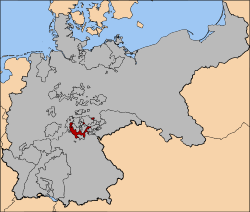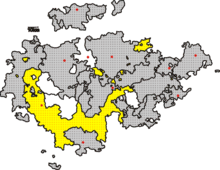- Saxe-Meiningen
-
Duchy of Saxe-Meiningen
Herzogtum Sachsen-MeiningenState of the Holy Roman Empire,
State of the Confederation of the Rhine,
State of the German Confederation,
State of the North German Confederation,
State of the German Empire← 
1680–1918 

Flag Coat of arms Anthem
Vaterlandsgesang der Sachsen-MeiningerSaxe-Meiningen within the German Empire Capital Meiningen Government Principality Duke - 1675–1706 Bernhard I - 1914–18 Bernhard III Historical era Middle Ages - Partitioned from
Saxe-Gotha1680 - Acquired
Saxe-Hildburghausen1826 - Duchy abolished 1918 - Merged into Thuringia 1920 Area - 1905 2,468 km2 (953 sq mi) Population - 1905 est. 269,000 Density 109 /km2 (282.3 /sq mi) The Duchy of Saxe-Meiningen was one of the Saxon duchies held by the Ernestine line of the Wettin dynasty, located in the southwest of the present-day German state of Thuringia.
Established in 1681,[1] by partition of the Ernestine duchy of Saxe-Gotha among the seven sons of deceased Duke Ernest the Pious, the Saxe-Meiningen line of the House of Wettin lasted, without much distinction, until the end of the German monarchies in 1918.
Contents
History
Upon the 1680 partition, the former Franconian lands of the extinct House of Henneberg fell to Ernest's third son, Bernhard, who chose the town of Meiningen as his residence and thereby became the first Duke of Saxe-Meiningen. From 1682 Duke Bernhard I had the Schloss Elisabethenburg built and in 1690 established a court orchestra (Hofkapelle), whose later Kapellmeister was Johann Ludwig Bach.
In the reshuffle of Ernestine territories that occurred following the extinction of the Saxe-Gotha-Altenburg line upon the death of Duke Frederick IV in 1825, Duke Bernhard II of Saxe-Meiningen received the lands of the former Duchy of Saxe-Hildburghausen as well as the Saalfeld territory of the former Saxe-Coburg-Saalfeld duchy. As Bernhard II had supported Austria in the 1866 Austro-Prussian War, the prime minister of victorious Prussia, Otto von Bismarck enforced his resignation in favour of his son Georg II, after which Saxe-Meiningen was admitted to join the North German Confederation.
In the German Revolution after World War I Duke Bernhard III, brother-in-law of Emperor Wilhelm II, on 10 November 1918 was forced to abdicate. The succeeding Free State of Saxe-Meiningen was merged into the new state of Thuringia in 1920.
In 1905 the capital Meiningen had an area of 2,468 km² and a population of 269,000. The summer residence was at Altenstein Castle. Since 1868 the duchy comprised the Kreise (districts) of Hildburghausen, Sonneberg and Saalfeld as well as the northern exclaves of Camburg and Kranichfeld.
The present head of the Ducal House of Saxe-Meiningen is Prince Frederick Konrad (born 1952). Since he has no heir, the representation of his house, after its extinction, will pass to the Head of the Grand Ducal House of Saxe-Weimar-Eisenach.
Dukes of Saxe-Meiningen
- Bernhard I (1680–1706)
- Ernst Ludwig I (1706–24), son of Bernhard I
- Ernst Ludwig II (1724–29), son of Ernst Ludwig I
- Karl Frederick (1729–43), son of Ernst Ludwig I
- Frederick Wilhelm (1743–46), son of Bernhard I
- Anton Ulrich (1746–63), son of Bernhard I
- Karl Wilhelm (1763–82), son of Anton Ulrich
- Georg I (1782–1803), son of Anton Ulrich
- Bernhard II (1803–66), son of Georg I
- Georg II (1866–1914), son of Bernhard II
- Bernhard III (1914–18), son of Georg II
Dukedom abolished in 1918
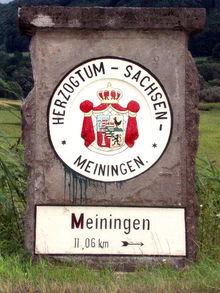 Restored boundary stone near Ellingshausen at the border with the Schleusingen district, from 1816 part of Prussian Saxony
Restored boundary stone near Ellingshausen at the border with the Schleusingen district, from 1816 part of Prussian Saxony
Heads of the Ducal House of Saxe-Meiningen, post-monarchy
- Bernhard III (1918–1928)
- Prince Ernst (1928–1941)
- Prince Georg III (1941–1946)
- Prince Bernhard IV (1946–1984)
- Prince Konrad (1984–Present)
References
- ^
 "Saxe-Meiningen". Catholic Encyclopedia. New York: Robert Appleton Company. 1913.
"Saxe-Meiningen". Catholic Encyclopedia. New York: Robert Appleton Company. 1913.
External links
- Saxe-Meiningen Family Genealogy
 Chisholm, Hugh, ed (1911). "Saxe-Meiningen". Encyclopædia Britannica (11th ed.). Cambridge University Press.
Chisholm, Hugh, ed (1911). "Saxe-Meiningen". Encyclopædia Britannica (11th ed.). Cambridge University Press.
 Upper Saxon Circle (1512–1806) of the Holy Roman Empire
Upper Saxon Circle (1512–1806) of the Holy Roman EmpireElectorates 
Ecclesiastical Secular Anhalt (Bernburg · Köthen · Zerbst) · Barby · Hatzfeld-Gleichen · Pomerania (Further · Hither) · Querfurt · Reuss (Elder · Junior) · Saxe-Altenburg · Saxe-Coburg · Saxe-Eisenach · Saxe-Gotha · Saxe-Weimar · Schwarzburg (Rudolstadt · Sondershausen)Prelates Counts / Lords Hohnstein · Lohra / Klettenberg · Mansfeld · Schönburg (Saale) · Stolberg (Stolberg · Wernigerode · Rossla)Saxe-Weimar (1572–1806) · Saxe-Coburg-Eisenach (1572–1596, 1633-1638) · Saxe-Coburg (1596–1633, 1681–1699) · Saxe-Eisenach (1596–1638, 1640–1644, 1672–1806) · Saxe-Altenburg (1603–1672, 1826–1918) · Saxe-Gotha (1640–1680) · Saxe-Gotha-Altenburg (1681–1826) · Saxe-Marksuhl (1662–1672) · Saxe-Jena (1672–1690) · Saxe-Eisenberg (1680–1707) · Saxe-Hildburghausen (1680–1826) · Saxe-Römhild (1680–1710) · Saxe-Saalfeld (1680–1735) · Saxe-Meiningen (1681–1918) · Saxe-Coburg-Saalfeld (1735–1826) · Saxe-Weimar-Eisenach (1806–1918) · Saxe-Coburg and Gotha (1826–1918)

 States of the Confederation of the Rhine (1806–13)
States of the Confederation of the Rhine (1806–13)Rank elevated
by NapoleonKingdomsGrand DuchiesStates created KingdomsGrand DuchiesPrincipalitiesPre-existing
statesDuchiesAnhalt (Bernburg · Dessau · Köthen) · Arenberg · Mecklenburg (Schwerin · Strelitz) · Nassau · Oldenburg · Saxony (Coburg-Saalfeld · Gotha-Altenburg · Hildburghausen · Meiningen · Weimar3 · Eisenach3 · Weimar-Eisenach4)PrincipalitiesHohenzollern (Hechingen · Sigmaringen) · Isenburg-Birstein · Liechtenstein · Lippe-Detmold · Reuss (Ebersdorf · Greiz · Lobenstein · Schleiz) · Salm5 · Schaumburg-Lippe · Schwarzburg (Rudolstadt · Sondershausen) · Waldeck1 from 1810. 2 until 1810. 3 until 1809. 4 from 1809. 5 until 1811. States of the German Confederation (1815–66)
States of the German Confederation (1815–66)Empires 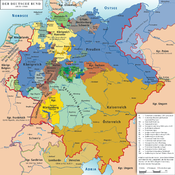
Kingdoms Electorates Grand Duchies Duchies Anhalt (Bernburg2 · Dessau2 · Köthen3) · Brunswick · Holstein · Limburg4 · Nassau · Saxe-Lauenburg · Saxony (Altenburg5 · Coburg-Saalfeld6 · Coburg-Gotha5 · Gotha-Altenburg6 · Hildburghausen6 · Meiningen)Principalities Hesse-Homburg · Hohenzollern (Hechingen7 · Sigmaringen7) · Liechtenstein · Lippe · Reuss (Elder · Junior) · Schaumburg-Lippe · Schwarzburg (Rudolstadt · Sondershausen) · Waldeck and PyrmontCity-states Other territories
outside of the
confederacyColonial possessions · Personal unions of Habsburg (Bukovina · Croatia · Galicia and Lodomeria · Hungary · Lombardy–Venetia · Serbian Voivodeship and Banat8 · Slavonia9 · Transylvania) · Personal union of Hanover (Great Britain and Ireland10) · Personal unions of Hohenzollern (East Prussia11 · Neuchâtel12 · Posen, Gr. Duchy13 · Posen, Prov.14 · Prussia, Prov.15 · West Prussia11) · Occupied: Schleswig161 w/o areas listed under other territories. 2 Merged with Anhalt from 1863. 3 until 1847. 4 from 1839. 5 from 1826. 6 until 1826. 7 until 1850. 8 1849–60. 9 as of 1849. 10 until 1837. 11 until 1829. 12 until 1848/57. 13 until 1848. 14 as of 1848. 15 as of 1829. 16 as of 1864. States of the North German Confederation (1866–71)
States of the North German Confederation (1866–71)Kingdoms 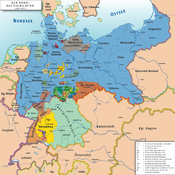
Grand Duchies Duchies Principalities Schaumburg-Lippe · Schwarzburg (Rudolstadt · Sondershausen) · Lippe · Reuss (Elder · Junior) · Waldeck-PyrmontCity-states  States of the German Empire (1871–1918)
States of the German Empire (1871–1918)Kingdoms 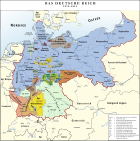
Grand Duchies Duchies Anhalt · Brunswick · Saxe-Altenburg · Saxe-Coburg and Gotha · Saxe-Lauenburg (until 1876) · Saxe-MeiningenPrincipalities Schaumburg-Lippe · Schwarzburg-Rudolstadt · Schwarzburg-Sondershausen · Lippe · Reuss Elder Line · Reuss Junior Line · Waldeck-PyrmontCity-states Other territories Categories:- Former principalities
- Former countries in Europe
- States of the Holy Roman Empire
- States and territories established in 1680
- States and territories disestablished in 1918
- 1918 disestablishments
- States and territories established in 1675
- States of the Confederation of the Rhine
- States of the German Confederation
- States of the North German Confederation
- States of the German Empire
- States of the Weimar Republic
- Ernestine duchies
- Dukes of Saxe-Meiningen
- House of Saxe-Meiningen
- House of Wettin
- History of Thuringia
Wikimedia Foundation. 2010.

